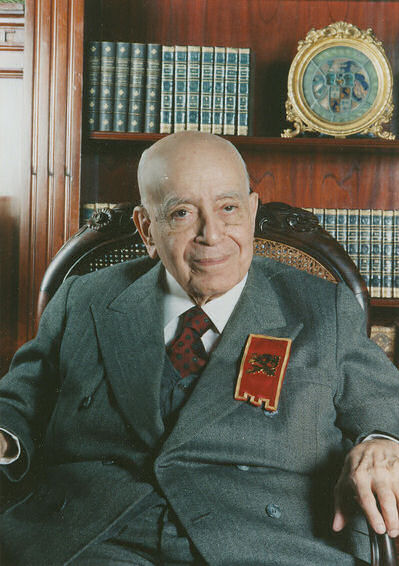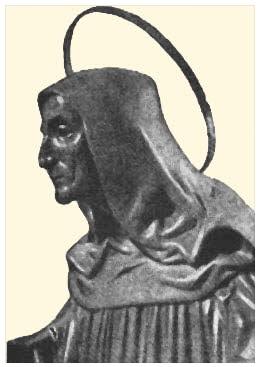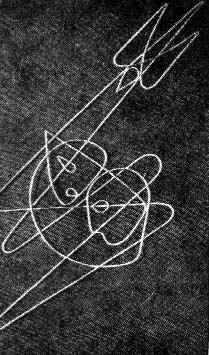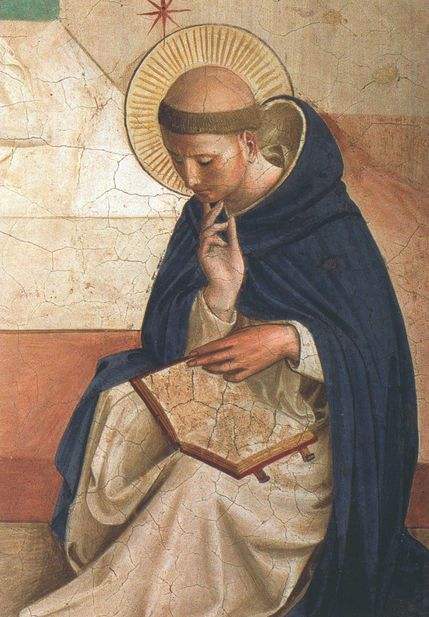by Plinio Corrêa de Oliveira
 In this article we discuss four pictures, two works of art from the fifteenth century, and two others from our times.
In this article we discuss four pictures, two works of art from the fifteenth century, and two others from our times.
The two paintings – “The Annunciation of the Blessed Virgin Mary” and “Saint Dominic in Prayer” – are the work of the famous fifteenth century artist Giovanni da Fiesole, better known as Fra Angelico. The work in metal, also representing the Annunciation, was done in our times by the artist H. Breucker. The sculpture was done by A. Wider, another contemporary artist, who has attempted to portray Saint Benedict, patriarch of Western monasticism.
Such striking (if not shocking) differences in the rendition of the same and similar subjects, i.e., the Virgin Mary and saints of the Catholic Church, demand some commentaries.
The famous scene of the apparition of the Archangel Saint Gabriel to the Blessed Virgin constituted a moment of grace for mankind. Heaven, which the guilt of Adam had closed, opened and a spirit of light and purity came down in angelic form, bearing a message of reconciliation and peace. This message was addressed to the most beautiful, most noble, most innocent, and most benevolent creature ever to be born of the race of Adam. The Gospels recount the elevated and ineffable simplicity of the dialogue between the two.
The artist’s task, challenged by such a theme, consists in expressing the moral values of that incomparable event in his rendition of the faces, attitudes, gestures, and setting as well as in his choice of colors and shapes.
Since this is printed in color, our readers can gauge Giovanni da Fiesole’s success in this objective. The nobility befitting the angelic nature, his light and totally spiritual fortitude, his intelligence and purity – all are admirably mirrored in this figure so highly expressive of Saint Gabriel.
The Blessed Virgin is less ethereal, less light. One could almost say less intangible. This effect is reasonable since she is a human creature. Nevertheless, something angelic is perceived in the whole composure of the Queen of Angels. Her facial features surpass those of the heavenly emissary himself in spirituality, nobility and innocence.
Something else is to be noted here; the attitude of one toward the other: By nature, the angel is superior to Our Lady. The Virgin, however, is superior to the angel by her sanctity and by her incomparable vocation as Mother of God. This accounts for the elevated dignity found in the rendition of both the Virgin and the angel and the reciprocal veneration with which they address each other.
There is, yet, a more profound reason for this attitude. Although unseen. God still manifests His Presence by a supernatural light that seems to radiate from both personages-a light that washes over all of nature with a splendor of pure, peaceful, and virginal happiness. One almost feels the most pleasant temperature, the very light and fragrant breeze, the joy that permeates the whole atmosphere.
How could a moment of grace be better painted? With a profound sense of the whole, Fra Angelico knew how to create the lines and colors needed to express all the theological and moral content of this Gospel episode famous a thousand times over. Indeed, his picture is more than just a painted scene. It is comparable to a sermon because it forms, elevates, and stimulates one who contemplates it toward the good.
A garish opposite is Breucker’s modern “Annunciation.” If a feeble minded person or someone delirious with a high fever were to ramble about the Annunciation, he might have conceived something like this. See how extremely extravagant the work is. It lacks the most elementary values and is devoid of any expression that would denote not only that which is elevated and supernatural but anything balanced or healthy as well. In short, everything works together to make this modern work a brutal and shocking antithesis of the picture from the fifteenth century. One is a marvel of spirituality and faith; the other, a product of a mentality that only knows how to see what is material-a psychology closed to the supernatural, a temperament that finds pleasure solely in horizons without beauty, nobility or anything which provides light, oxygen, life, and hope of eternity for the soul.
In his allocution on May 24, 1953, the Holy Father Pius XII defined the so-called modern spirit as “materialistic thought transposed into actions.” In like manner, the example of art depicted here can be classified as materialistic thought transposed into art.
Now, look at the picture of Saint Dominic. Elements of the spiritual shine admirably forth in it. It is more a portrait of the soul than of the body. The effort of thought, the exertion required for reading, the serene but strong strain of intellectual work, a countenance befitting one who understands and takes pleasure in understanding all, ultimately, are expressed here with unequaled discretion, intensity and veracity.
And still other aspects of the soul appear: the liveliness and exuberance of a young man, the equilibrium, innocence, piety, and temperance of a perfect religious.
In comparison to this second masterpiece from the fifteenth century, consider the statue from the twentieth century. Certainly there are considerable factors bearing on such a comparison: a) the materials of a painting and those of a sculpture are not the same; b) the talents and temperaments of the artists are also different; c) finally, the spirit of the two subjects. Saint Dominic and Saint Benedict also differ.
Is there a shock, a violent contrast? By no means. Does Wider’s sculpture merit the censures that we made of the work by Breucker? No. On the contrary, Wider’s statue expresses-with much propriety, precision and strength-the idea that one may have of the patriarch of Western monasticism, who was a model of gravity, austerity, manly tranquility, profound recollection and great wisdom.
 No one can deny that this sculpture corresponds satisfactorily to the requirements of an authentic artwork marked by orthodox and well-balanced piety.
No one can deny that this sculpture corresponds satisfactorily to the requirements of an authentic artwork marked by orthodox and well-balanced piety.
Are we against the modern? By this word one understands that which not only pertains to but is typical of our times but rather something a) inherent to it b) different from the past, and c) distinct from the future.
More and more – not only in the field of art but in other areas as well – clever, pertinacious, and all encompassing propaganda is introducing a certain spirit of materialism, sensuality, and delirious extravagance. The style animated by this spirit masterminds the construction and reconstruction of entire cities; it marks the external design and interior decoration of the majority of new buildings of great, medium, or even small importance, in all parts of the world. It exhibits its works in universal art expositions, and so on.
The man in the street instinctively reacts against it… but only slightly. Thus, this spirit already is – or is on the way to becoming-the style of our twentieth century, which distinguishes it from the past, and God willing, from the days to come.
If it is this and only this that one calls modern, if to be modern is to accept the mark or stigma of materialism – not only of radical materialism but also of “moderate” materialism with all its hues and misrepresentations – then it is undeniable that we are anti-modern because we are Catholic.
However, if one takes into account that alongside this offensive current of our century there are still artists animated by another spirit, and if one means by modern that everything contemporary is modern – whatever be its inspiration, then we cannot be anti-modern because we are not idiots. There is no other name for anyone who, in the ocean of cultural productions of the twentieth century, would judge everything preconceivedly and indiscriminately bad – both the works engendered by the children of light and the works influenced by the neopagan spirit, that is, the spirit of darkness.
Considering these two definitions of modern, which is the more true? It is a problem of semantics. However, one thing is certain: if the materialistic style should not be called “modern,” then another name should be devised for it, which has not happened yet. And this name ought to take into account that the modern torrent contains not only the materialistic ingredients we are talking about, but also gnostic and satanic elements (which are the subject matter for another article).
To give a name to this current is an interesting assignment on which we invite our readers to test their wits. However, naming this phenomenon is not the most urgent thing. The twentieth-century man in the street still does not accept the “modern” in the depths of his soul. Let us preserve him from this disgrace. Let us be “modern” in the sense that we behave in accordance with the problems and dangers of our century.
This is what we are trying to do in these articles, amidst the clamor of much applause and to the muffled and furious snarls of hatred of some-certain though, whatever the case, of fulfilling a sacred obligation.
Ambience Customs & Civilization, No. 38 – February 1954














